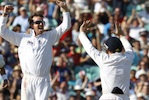CTV’s long summer of cricket
 Weather permitting, the Fourth Test starts today as England take on India at The Oval in London. Cricket, especially the five-day long Test match version, might seem the most genteel of sports, but Hamish Greig, Technical Director at CTV which undertakes the coverage for Sky Sports, likens it to a FA Cup Final taking place for five days in a row for the crews involved.
Weather permitting, the Fourth Test starts today as England take on India at The Oval in London. Cricket, especially the five-day long Test match version, might seem the most genteel of sports, but Hamish Greig, Technical Director at CTV which undertakes the coverage for Sky Sports, likens it to a FA Cup Final taking place for five days in a row for the crews involved.
“Test cricket is one of the most complicated OBs you can work on basically because of the amount and variety of cameras you have to deal with,” he says. “It’s like doing an FA Cup Final every day because of the range of facilities we have to provide – it’s not just a bog-standard 18 cameras and a commentary.”
Greig’s camera list is almost as long as the game itself. It starts with six Sony HDC-3300 super slo-mos, Steadicam, 12 Sony HDC-1500s fitted with 76:1 and 86:1 lenses, and a three camera studio. It then gets complicated, partly because Sky Sports and the governing body the ECB have been at the forefront of developing video aides for umpires.
Hawkeye can track the ball for adjudicating LBW decisions (though not in this series at India’s request – which is one that’s already back-fired on the team on several occasions), Hot Spot uses infra-red cameras to detect ball impacts, while run-out cameras can tell if a batsman has made his crease in time before the bails come off. In a few short years, in other words, cricket has gone extremely high-tech; not without some soul-searching about the nature and spirit of the game admittedly, but it certainly presents an interesting contrast to FIFA and the latter’s attitude to Goal Line Technology.
But we digress…
“Then on top of that you’ve got two ARRI P600 high-motion cameras,” continues Greig, “on top of that you’ve got six Hawkeye cameras, on top of that you’ve got four run-out cameras at 90 degrees to the crease, on top of that you’ve got two HD stump cameras, on top of that you have a commentary camera, and on top of that you’ve got four hot spot cameras. All in all there are about six different flavours of camera.”
Add in a vast array of mics, including two Soundfield 5.1 units, 11 EVS servers, all networked, two Avid edit suits with IPDirector, 2 x Sony SRW and 4x HDCAM VCRs, plus the radar gun for detecting the speed of the bowlers (90mph is not uncommon), and you can see what Greig means about complexity.
The game is long too. Tests can be on air from 10.30 to 19.00 for five days, though the recent series has seen a woefully underprepared and demotivated Indian team often beaten in under four days as England have gone on to be officially recognised as the best team in the world.
“The cricket season is a very hard schedule,” says Greig. “There’s cricket on every day of the week somewhere, and the crews have a hard time of it. So, if a five day test finishes after four and they get an extra day at home, then that’s a huge bonus for them.”
